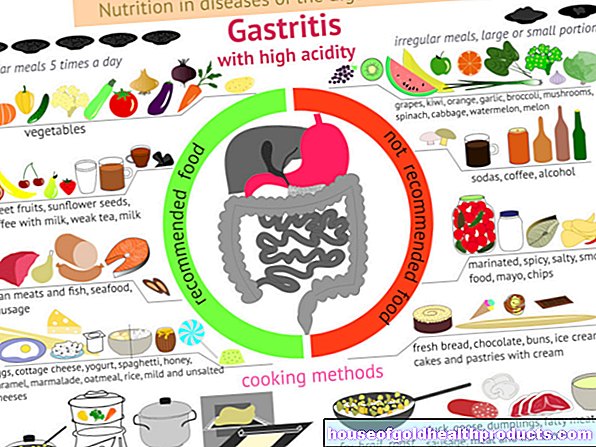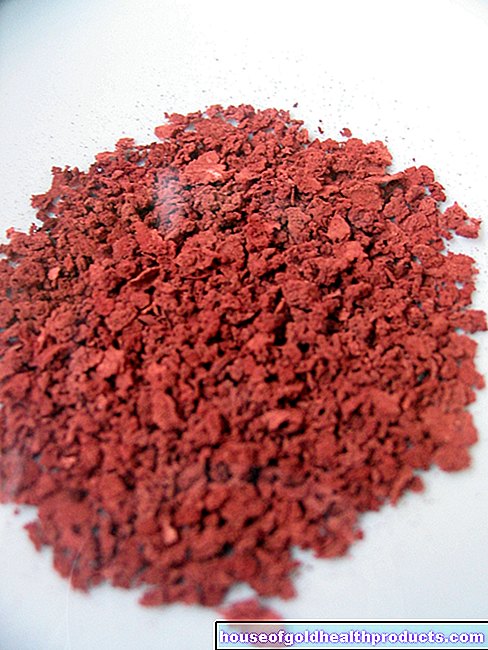Vitamin A
Carola Felchner is a freelance writer in the medical department and a certified training and nutrition advisor. She worked for various specialist magazines and online portals before becoming a freelance journalist in 2015. Before starting her internship, she studied translation and interpreting in Kempten and Munich.
More about the experts All content is checked by medical journalists.Like vitamins D, E and K, vitamin A is one of the fat-soluble vitamins. It is contained in foods of animal origin and in plant foods in the form of the precursor beta-carotene. Vitamin A is important for the eyes and skin, as well as for the bones and teeth, among other things. Find out how much vitamin A you need and what foods contain it.
What is Vitamin A?
Vitamin A is a group of compounds that have a similar effect in the body. These include, for example, retinol (the transport form of the vitamin within the body), retinal and retinoic acid. In addition, beta-carotene is a precursor of the vitamin (provitamin): it is converted into active vitamin A in the body.
Vitamin A is absorbed into the blood in the small intestine from food. As a fat-soluble vitamin, it can be stored in the body. This mainly happens in the liver.
What are the tasks of vitamin A in the body?
Vitamin A is involved in the visual process (especially at night) because, in the form of retinal, it is part of the visual purple (rhodopsin) in the retina. There it is built into the rods and thus helps to differentiate between light and dark.
In addition, vitamin A plays a role in reproduction: it plays a role in the production of testosterone, in the development of sperm cells, in the structure of the placenta (placenta) and in the maturation of the fetus.
We also need vitamin A for healthy bones, cartilage and teeth.
Skin build-up and regeneration are also supported by the vitamin, more precisely by retinol. This is converted into vitamin A acid (retinoic acid) in the skin, which is supposed to maintain the skin's elasticity. This is why retinol is often found as an ingredient in skin creams and serums.
Beta-carotene, the precursor of vitamin A, helps against free radicals: These are aggressive oxygen compounds that are constantly created in the body (during metabolic processes, through UV radiation, nicotine, medication, etc.). They are dangerous because they can damage cells and the genetic material DNA. Beta-carotene has an antioxidant effect, so it can help to "defuse" free radicals.
What is the daily requirement of vitamin A?
The recommended intake for vitamin A depends, among other things, on age and gender. In addition, the daily vitamin A requirement can be slightly increased during pregnancy and breastfeeding.
According to the recommendation of the German Nutrition Society (DGE), you should consume this much vitamin A daily:
|
age |
Retinol mg / day | ||
|
masculine
|
Female | ||
|
0 to under 4 months |
0,5 |
0,5 | |
|
4 to less than 12 months |
0,6 |
0,6 | |
|
1 to under 4 years |
0,6 |
0,6 | |
|
4 to under 7 years |
0,7 |
0,7 | |
|
7 to under 10 years |
0,8 |
0,8 | |
|
10 to under 13 years |
0,9 |
0,9 | |
|
13 to under 15 years |
1,1 |
1,0 | |
|
15 to under 19 years |
1,1 |
0,9 | |
|
19 to under 25 years |
1,0 |
0,8 | |
|
25 to under 51 years |
1,0 |
0,8 | |
|
51 to under 65 years |
1,0
|
0,8 | |
|
65 years and older |
1,0 |
0,8 | |
|
Pregnant women from the 4th month |
1,1 | ||
|
Breastfeeding |
1,5 | ||
Vitamin A: foods high in content
There is plenty of vitamin A in liver, kale and carrots, for example. You can read more about this in the article Foods with a high vitamin A content
How does a vitamin A deficiency manifest itself?
You can read everything you need to know about how a vitamin A deficiency develops, how it manifests itself and what consequences it has in the article Vitamin A deficiency.
How is an excess of vitamin A expressed?
A vitamin A overdose can occur if someone takes vitamin A for a long time - for example on their own or as part of a therapy, for example for acne or psoriasis. Even with chronic kidney failure (chronic kidney failure), an excess of vitamin A can develop in the body.
Acute overdose manifests itself in headache, nausea and vomiting.
If the vitamin A excess develops over a long period of time (chronic overdose), it can lead to sleep disorders, irritability, loss of appetite, dry skin, dry mucous membranes and hair loss, among other things. The bones become more fragile and the liver is damaged. In pregnant women, an excess of vitamin A can damage the unborn child. Expectant mothers should therefore seek advice from their gynecologist regarding their vitamin A intake.
The excessive intake of beta-carotene (precursor of vitamin A) can cause harmless yellowing of the skin, especially on the palms of the hands and feet. In smokers, excess beta-carotene can increase the risk of lung cancer.
Tags: digital health healthy feet healthy workplace





























